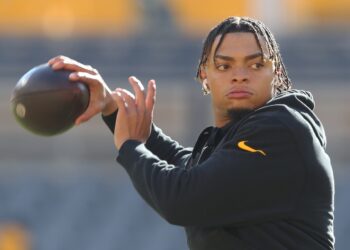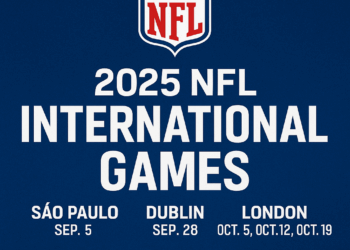Featured Editorials Home Slider
The Wide Receiver Depth Competition
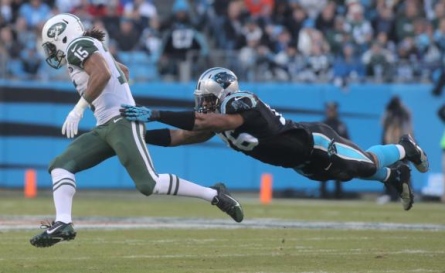
The Jets should have plenty of competition during training camp this year, but one of the most interesting battles will take place for the fifth and possibly sixth wide receiver positions on the roster. The first four spots on the WR depth chart should be Brandon Marshall, Eric Decker, Jeremy Kerley, and Devin Smith barring unforeseen injuries. Most teams tend to carry five wide receivers, but the Jets might be forced to carry six by necessity due to a lack of an established punt/kick returner on the main roster.
The 5th WR position:
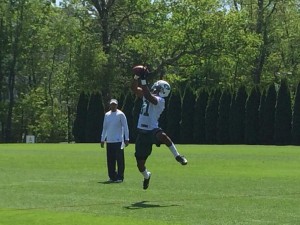 Shaq Evans: The highest WR pick from last year’s haul that is still on the team, Evans offers plenty of potential with his physical abilities. Evans posted a 4.4 forty yard dash, with an impressive shuttle time of 4.21 prior to the draft last year, showcasing excellent speed in workouts. To put the times in perspective, his 40 yard dash, size, broad jump, and shuttle times are very similar to fellow Pac 12 player Nelson Agholor, who was a first round pick of the Eagles in the 2015 draft. The biggest difference however, is that Agholor has a much better three cone drill time, showing his ability to change directions faster than Evans, therefore helping him play in the slot to greater effectiveness. For all his physical abilities, Evans is raw in his ability to catch the pass, but shows good route running potential and ability to create separation. While Evans did return a total of 26 punts in his college career, he lacks the shiftiness necessary to be effective in that position. His hands are probably his biggest question mark, thus he will most likely not be considered an option for punt or kick returns.
Shaq Evans: The highest WR pick from last year’s haul that is still on the team, Evans offers plenty of potential with his physical abilities. Evans posted a 4.4 forty yard dash, with an impressive shuttle time of 4.21 prior to the draft last year, showcasing excellent speed in workouts. To put the times in perspective, his 40 yard dash, size, broad jump, and shuttle times are very similar to fellow Pac 12 player Nelson Agholor, who was a first round pick of the Eagles in the 2015 draft. The biggest difference however, is that Agholor has a much better three cone drill time, showing his ability to change directions faster than Evans, therefore helping him play in the slot to greater effectiveness. For all his physical abilities, Evans is raw in his ability to catch the pass, but shows good route running potential and ability to create separation. While Evans did return a total of 26 punts in his college career, he lacks the shiftiness necessary to be effective in that position. His hands are probably his biggest question mark, thus he will most likely not be considered an option for punt or kick returns.
Shaq Evans fit on the roster should most prone be the backup to the outside receivers on the team, as he doesn’t posses the ability to quickly change directions, and takes time to get upto speed. He does possess good upside with his route running ability and top end speed. Evans has performed well in minicamp so far this year, after having a horrible training camp last year. The high end potential should have Evans as the leading candidate for the job, entering training camp, but there are plenty of others vying for the position.
DeVier Posey: The Jets new GM Mike Maccagnan traded for one of the players he helped draft with the Texans in DeVier Posey. The Jets traded the 70th overall pick for the 82nd overall pick, the 152nd overall pick, the 229th overall pick, along with Posey. In terms of trade charts, to equalize the trade value, Posey has to be valued at a 5th round value. The 70th pick holds a value of 240, while the 82nd pick has a value of 180, thus a difference of 60 points. The 5th round pick net the Jets a value of 30.6, but the 7th round pick does not show up in the trade chart value, thus considered negligible for this purpose. So the Jets theoretically valued Posey at a 5th round value for this trade to go be deemed fair in terms of the trade chart.
Posey, possesses an intriguing combination of size and speed, with a good ability to run routes and gain separation. However, three years after being drafted, Posey hasn’t done much in the NFL, partially because of an Achilles tendon injury and the inability to gain playing time afterwards. Achilles tendon injuries are devastating to an athlete, many a times causing players to retire, and it’s estimated that in most cases the full function never returns. Posey wasn’t on the field much of last year, and the possibility exists that he may never recover the explosiveness that made him such a good player at Ohio State. The wide receiver returned a grand total of four punt returns in his college career and none in his NFL career, thus he can be counted out from the punt returner/kick returner sweepstakes. Posey fits well into the system because of his route running ability, size, and speed, but doubt lingers about his explosiveness after the injury. If Posey has lost a step from his days in college, then there are too many talented WRs on the team right now for him to make it. If he recovered his explosiveness, thereupon this might be the best competition in camp.
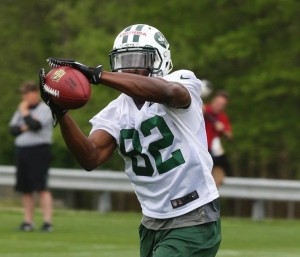 Quincy Enunwa: The Jets drafted Enunwa in the 6th round of the 2014 NFL draft, and he spent much of last year on the practice squad. The former Cornhusker is another WR that posses very good speed to go along with good size, showcasing 4.4 forty yard dash stats at 6’2” during the combine. Enunwa, was a raw WR branded as a body catcher who had trouble in and out of breaks, but has excellent size to block out corners and fight for the ball. His lack of ability to change directions quickly also limits him to be an outside WR, and faces an uphill battle to overtake Shaq Evans.
Quincy Enunwa: The Jets drafted Enunwa in the 6th round of the 2014 NFL draft, and he spent much of last year on the practice squad. The former Cornhusker is another WR that posses very good speed to go along with good size, showcasing 4.4 forty yard dash stats at 6’2” during the combine. Enunwa, was a raw WR branded as a body catcher who had trouble in and out of breaks, but has excellent size to block out corners and fight for the ball. His lack of ability to change directions quickly also limits him to be an outside WR, and faces an uphill battle to overtake Shaq Evans.
The one aspect where Enunwa may have an upper hand over the others in this competition is his ability to block, as he’s an excellent blocker down the field and in the running game, especially coming from a run oriented offense at Nebraska. Chan Gailey has a propensity for having various screen passes mixed into his offense, thus the excellent blocking skills could help set Enunwa apart when he’s on the field. The WR has been doing good at minicamp, apparently catching all the balls thrown his way in Day 2, so he is showing some improvement from last year. Enunwa only had one kick return in his college career, and has no NFL stats, thus he can also be eliminated from the return game competition.
Jonathon Rumph: The Jets signed Rumph after rookie minicamp tryouts, using the spot cleared up by the release of Matt Simms. The former Georgia Bulldog is a 6’4” WR, showcasing excellent size, but below average speed, clocking in at 4.74 in the forty yard dash. Rumph was a highly touted recruit out of junior college, but failed to make much of an impression in the SEC because of consistent hamstring injuries. The lack of production in college, and the limited upside could end up leaving Rumph as a possible conversion candidate to TE, because he does not seem fluid enough as a WR playing the outside or slot position. He did not return punts or kicks during college, thus can be eliminated from the competition as well for those duties. The size however could provide useful in red zone situations, somewhere the Jets desperately need help.
The competition for the 5th WR spot should be enticing, as there are three legitimate candidates with very good skill sets vying for what should only be one spot on the roster. Rumph is a darkhorse, but most likely is going to see the practice squad as his best case scenario right now. There isn’t much talent that separates Evans, Posey, or Enunwa, thus how they perform during training camp will go a long way into determining who gets to suit up for opening day, and who doesn’t.
The 6th WR Position (Kick Returner/Punt Returner):
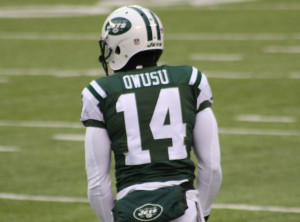 Chris Owusu: The former Stanford alum made quite an impression last year for the Jets in limited playing time, rushing for a TD last year against the Dolphins in Week 17. Owusu ran the second fastest 40 yard dash at the NFL combine in 2012 with a 4.31, coming in second behind Jets fan favorite, Stephen Hill. However, Owusu was not drafted mainly because he had an extensive history with concussions, causing many teams to pass on the talented WR. The biggest scare came against Oregon State, when he had to be carted off the field after a concussion. When healthy, Owusu displays excellent speed, vertical jump, change of direction, and explosiveness. Owusu showed a good knack of getting in and out of breaks, and showed quickness in college.
Chris Owusu: The former Stanford alum made quite an impression last year for the Jets in limited playing time, rushing for a TD last year against the Dolphins in Week 17. Owusu ran the second fastest 40 yard dash at the NFL combine in 2012 with a 4.31, coming in second behind Jets fan favorite, Stephen Hill. However, Owusu was not drafted mainly because he had an extensive history with concussions, causing many teams to pass on the talented WR. The biggest scare came against Oregon State, when he had to be carted off the field after a concussion. When healthy, Owusu displays excellent speed, vertical jump, change of direction, and explosiveness. Owusu showed a good knack of getting in and out of breaks, and showed quickness in college.
His career in the NFL has not gone smoothly, as he has a grand total of 20 receptions in three years, mostly with the Tampa Bay Buccaneers. He was a fearsome kick returner in college, racking up 78 returns and 3 TDs during his career. In the NFL, Owusu did not return kicks until last year, when he made three returns to the average of 49 yards per return, including an 87 yard return with the Jets last year.
Amongst the players competing for the No. 6 position, Owusu offers the highest upside in terms of both his WR abilities and his return abilities. However, the upside is countered by the highest downside as well because of his concussion history. One of the biggest reasons the NFL moved kickoffs forward was to reduce the number of concussions, because the resulting high speed collisions that occurred on those plays put the players at the most risk for head injuries. The injury history here is a major concern, and could be a considerable factor as to why the others on this list have a good shot at taking over this roster spot. Owusu would provide a speed back up to Devin Smith (who only returned kicks his first two years in college) in the WR formation, but the 6th WR most likely also has to be able to return kicks/punts.
Walter Powell: The Arizona Cardinals drafted Powell in the sixth round of the 2014 draft, and the Jets claimed him off waivers last September. Powell posted a 4.44 forty yard dash at his Pro Day, along with excellent three cone and shuttle times, showing his ability to move quickly. Powell was the leading WR at Murray State, piling up 208 catches during his career. Powell is mainly a slot WR, that showcased the ability to work the underneath routes and gain yards after the catch. Powell excels in the return game and was considered one of the better return prospects in the draft last year. Powell returned 12 punts, and 8 kickoffs last year, including a 62 yard return with the Jets, however he has no stats as a WR.
Powell showed himself to be a good WR in college, with decent stats, and has shown a knack to be a good returner. With the injury history of Owusu, Powell may have the upper hand in terms of the competition because he is less risky. He doesn’t offer the upside of Owusu because he is not as polished a WR and lacks the top end speed of Owusu, but offsets it with the lesser degree of risk. It also helps Powell’s case that he has a history with returning punts along with kicks, freeing up Jeremy Kerley to do his arm stretches on the sideline, instead of on the field.
TJ Graham: The Jets signed the speedster Graham last year after he was released by the Bills, and then subsequently by the Titans. Graham was a track star in college, and possess excellent speed and showed improvement as a WR during his college years. He mostly ran vertical routes in college, and isn’t quick or shifty in short areas as much as Powell or Owusu. Graham had a total of 99 catches in his college career, with 12 TDs. However, he did have 137 kick returns and 66 punt returns, with 2 TDs apiece in each category. In his NFL career, Graham has 57 catches with 4 TDs, while having 7 kick returns with no TDs, with longest run being 23 yards.
Graham is more established as a WR than Powell, but not nearly established as him in the return game, and clearly behind Owusu in both aspects. Graham may have one factor working for him, his connection to Chan Gailey. The Buffalo Bills traded up in the third round to pick Graham while Gailey was the head coach of the team in 2012. With his lack of punt returns, Graham is most likely behind Powell going into training camp for this competition. His stats in kick returns leaves one underwhelmed when you consider his top end speed, and his lack of shiftiness in space makes him a less than ideal candidate to be a punt returner.
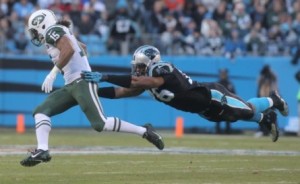 Saalim Hakim: The 5’11” WR might be the fastest player on the Jets, as he reportedly clocked in at 4.23 in the 40 yard dash during his Tarleton State Pro Day. Hakim is the brother of Az-Zahir Hakim, a productive WR part of the “greatest show on turf” days with the Rams. The younger Hakim has been in the league since 2012, but does not have a catch, however he is credited with 13 kick returns for 279 yards, the longest being 44 yards.
Saalim Hakim: The 5’11” WR might be the fastest player on the Jets, as he reportedly clocked in at 4.23 in the 40 yard dash during his Tarleton State Pro Day. Hakim is the brother of Az-Zahir Hakim, a productive WR part of the “greatest show on turf” days with the Rams. The younger Hakim has been in the league since 2012, but does not have a catch, however he is credited with 13 kick returns for 279 yards, the longest being 44 yards.
Hakim posses excellent speed, but hasn’t translated it much to the playing field, especially during returns. He is very raw, as he did not start playing football until his senior year of high school, but right now is clearly behind the other receivers because he hasn’t shown the ability to be a good WR nor has he done an amazing job in kick returns. Nonetheless, he possesses the best speed tool amongst the group, and if he can make a leap in his ability to run routes or read blocks as a kick returner, then he can vault into the lead. As of now, he might be an injury insurance for the others on this list.
Side Note- Speed: The Jets have lacked speed for years, but they seemed to have fallen in love with the WR speed demons of the 2012 draft. Besides Hakim, the Jets have at one point had the top 40 yard dash WR speedster (Stephen Hill), the second speedster (Chris Owusu- technically tied for second), the fourth speedster (TJ Graham), and eleventh speedster (DeVier Posey).
Overall, the Jets for the first time in a long time have excellent depth at the WR position. The Jets should most likely carry 6 WRs because there are no RBs that can carry the kick return/punt return duties. The only other option might be Antonio Cromartie as a kick returner, but he did not return any last year, and at his age, the risk might be too much considering how valuable he is to the secondary. The 5th WR position should be the backup to Marshall/Decker, alas someone who is a possession receiver and has size to matchup with the bigger corners in the NFL. Evans has the most potential amongst the group, but Posey and Enunwa aren’t far behind. Devin Smith and Jeremy Kerley can play the slot, so the 6th WR spot is wide open. Owusu is the most talented, but also the most flawed in terms of risk, while Powell, Graham, and Hakim have issues of their own. While the word competition was thrown around somewhat loosely in the last two years, this year should entail a fierce battle between some talented players. For once, other teams might be waiting to see who we cut, instead of the other way around.
Videos
Prime Time Team no More; Taking a Look at Jets 2025 Schedule



